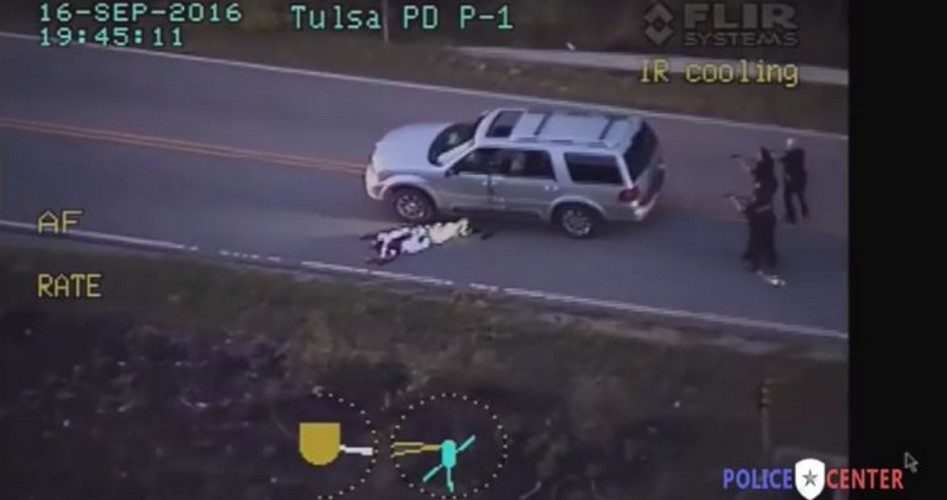
The Oklahoma chapter of the Council on American-Islamic Relations (CAIR-OK) has taken a stand against the acquittal of police officer Betty Shelby for shooting and killing Terence Crutcher in September of last year in Tulsa, Oklahoma. The Islamic group announced that it is siding with Black Lives Matter (BLM), which has called for Shelby to be fired from the Tulsa police force, despite her being found not guilty of any crime.
CAIR also supports BLM’s call for the creation of a Citizen’s Advisory Council. Citizen’s Advisory Councils (sometimes referred to in past years as Citizen Review Boards) have long been advocated by those who want to undermine the work of local police departments. It should be understood that there are already checks in place against police misconduct. As it stands now, police have Internal Affairs departments, which investigate alleged police misconduct, and district attorneys have the authority to file criminal charges — as happened in this case. But a jury found Shelby not guilty of manslaughter, after hearing the evidence. That is the system of due process of law under which we operate in America.
But a trial, followed by a jury verdict, is not sufficient for BLM and CAIR. CAIR’s Civil Rights Director Veronica Laizure said, “We are disappointed that Officer Shelby was not found guilty of manslaughter despite the overwhelming evidence. We support Black Lives Matter Oklahoma in their demands for the creation of a citizen’s advisory commission and for the dismissal of Officer Shelby from the Tulsa Police Department, as well as for better policies, implicit bias training, and stronger oversight procedures.”
Shelby shot Crutcher last year when his SUV was stalled on a city street in Tulsa. She told investigators and the jury that she fired her gun because he ignored her repeated commands to lie down, he kept reaching into his pockets, and that he reached into his car. According to testimony delivered during the trial, police officers such as Shelby are taught that when a person ignores commands as did Crutcher, and reaches into a car, it is considered proper police procedure to consider that the person is reaching for a weapon.
Shelby’s attorney, Shannon McMurray, argued that while Shelby could have used her stun gun instead of a gun, she had to make a “split-second” decision. “Could she have used a Taser? Yes, might she be dead? Yes,” McMurray said. “It’s a classic law school exam: All the answers are right, but which ones are the most right?”
Shelby testified that she thought Crutcher’s behavior indicated that he was under the influence of PCP. PCP is also known as Angel Dust, and it is a powerful hallucinogenic that causes users to act erratic and become combative. An autopsy did reveal that PCP was in Crutcher’s system, and a vial of PCP was found in his vehicle.
CAIR, BLM, and even an Associated Press article made a connection between this incident and the Tulsa Race Riot of 1921. CAIR noted that the acquittal came “less than two weeks before the 96th anniversary of the Tulsa Race Riot, one of the largest and most destructive anti-Black massacres in American history.” While CAIR is an activist organization, and not expected to take an objective journalistic response to the tragic killing of Terence Crutcher, and the subsequent not-guilty verdict of Officer Shelby, AP also added about five paragraphs to the end of its story, linking the not-guilty verdict to “racial disparities” in mostly black north Tulsa, where neighborhoods are “without a real grocery store and a ZIP code where a black baby has 10 years less life expectancy than a white baby.” How sending Betty Shelby to prison would affect the number of grocery stores in a particular neighborhood is not explained.
AP even said the acquittal “shows a larger failure of the legal system — and by extension society — to recognize the value of a black man’s life.”
It should not be forgotten that in our legal system, juries hear specific cases, and consider specific evidence before rendering a verdict. Society was not on trial — one Tulsa police officer, Betty Shelby, was. In fact, Shelby’s lawyer even accused the district attorney of filing the charges against Shelby for political, not legal, reasons. McMurray alleged that the prosecution feared civil unrest as has happened in other locales, when a police officer is found not guilty.
Shelby getting her job back means “she’s getting the due process she wasn’t afforded when they jumped the gun and charged her,” McMurray said.
Apparently, the jury, which consisted of eight women and four men, agreed with the defense’s case. The jury also included three blacks, who apparently also believed, after hearing and viewing all the evidence, that Officer Shelby was not guilty. After the jury deliberated for nine hours, they concluded that the state had failed to prove Officer Shelby guilty of manslaughter. They must not have realized that they were supposed to take the 1921 Tulsa race riot, the lack of grocery stores in the area, and the like into consideration during their deliberations.
The jury foreman, however did say that Shelby was not “blameless” in Crutcher’s death. He added that Shelby could have used her Taser before Crutcher made it back to his car.
Of course, it is very easy to second-guess a police officer in a situation such as that which confronted Shelby. While she may have handled things differently, the jury found her not guilty of the crime she was accused of — manslaughter.
Oklahoma Governor Mary Fallin summed up the proper reaction to the verdict: “I ask Oklahomans to respect our criminal justice system and especially the jurors, who heard the evidence from both sides in this case. Those who disagree with the verdict have the right to express their opinions; I just ask that they do so in a peaceful manner. I appeal to Tulsans and other to remain calm. Our thoughts and prayers should be with the Terence Crutcher and Betty Shelby families during this difficult time.”
But what of BLM and CAIR? Are they just two groups interested in truth and justice? Not hardly. As Mitchell Shaw wrote in The New American last fall, “Time and again BLM has seized upon the deaths of dangerous criminals to foment violence and destruction. Recent examples include Alton Sterling in Baton Rouge and Sylville Smith in Milwaukee. In both cases, black men were armed, were in the process of committing crimes, refused to obey lawful orders from police, and attempted to use their weapons on police. In both cases, police officers shot and killed the criminals. In both cases, BLM used the deaths of dangerous criminals as a pretext for violence while shouting “Black Lives Matter!”
And what of CAIR? Is it simply a civic-minded group concerned about “civil liberties of all persons?” Writing in National Review in 2014, Daniel Pipes said, “It apologizes for terrorist groups: Challenged repeatedly to denounce Hamas and Hezbollah as terrorist groups, CAIR denounces the acts of violence but not their sponsors. It is connected to Hamas: Hamas, designated a terrorist organization by the U.S. and many other governments, indirectly created CAIR and the two groups remain tight. Examples: In 1994, CAIR head Nihad Awad publicly declared his support for Hamas; the Holy Land Foundation (HLF), a Hamas front group, contributed $5,000 to CAIR; in turn, CAIR exploited the 9/11 attacks to raise money for HLF; and, this past August, demonstrators at a CAIR-sponsored rally in Florida proclaimed ‘We are Hamas!’”
While no police officer is perfect, as no person is perfect, it should be of concern that organizations such as CAIR and BLM seize upon tragedies such as this unfortunate shooting in Tulsa to advance their radical anti-local police agenda.
Photo of Terence Crutcher immediately after being shot: screenshot of Tulsa Police video



